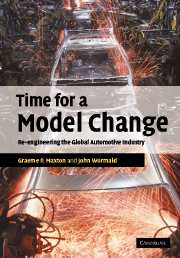Book contents
- Frontmatter
- Contents
- List of figures
- Foreword by G. Fredric Bolling
- Acknowledgements
- Glossary
- Introduction
- 1 From automania to maturity – in the main markets at least
- 2 The problems that can be fixed – dealing with noxious emissions, traffic accidents and congestion
- 3 The global resource challenges – energy and global warming
- 4 A global industry and the changing international order
- 5 The supplier industry – the catalyst for the profound changes to come?
- 6 The downstream sales and service sector
- 7 When the labels do not add up
- 8 Choosing a future for the automotive industry
- 9 Time for a model change
- Index
Foreword by G. Fredric Bolling
Published online by Cambridge University Press: 22 September 2009
- Frontmatter
- Contents
- List of figures
- Foreword by G. Fredric Bolling
- Acknowledgements
- Glossary
- Introduction
- 1 From automania to maturity – in the main markets at least
- 2 The problems that can be fixed – dealing with noxious emissions, traffic accidents and congestion
- 3 The global resource challenges – energy and global warming
- 4 A global industry and the changing international order
- 5 The supplier industry – the catalyst for the profound changes to come?
- 6 The downstream sales and service sector
- 7 When the labels do not add up
- 8 Choosing a future for the automotive industry
- 9 Time for a model change
- Index
Summary
The automotive sector is a critically important and complex one. Other than the vehicles themselves, and the roads and fuel needed to run them, the business is intricately tied to the manufacture of a wide range of components and the extraction of precious raw materials. It is linked closely to the policies of governments, the earnings of banks. Indirectly, it brings us road congestion, too many fatalities and a wave of other environmental troubles. In many ways, the automotive sector offers an almost endless stream of social, political and economic inter-connections which affect us all in some way. As you read their exciting book you realise how much the authors know about this world and how compellingly they express their knowledge to build yours. The shock comes when you wake up to the questions they pose.
Readers of their first book, Driving Over a Cliff published a decade ago, will see a continuing progression in the ruinous steps which have forced the industry into a socio-politico-economic corner. Whether this slide is related to flat demand or to the industry's creation of an ever-wider range of vehicles that many buyers seem to care little about, there is a problem. As with most ageing systems, problem descriptions are difficult because we like to hear problems defined in terms of potential solutions. Yet none are evident – or at least none that will be easy for the protagonists to apply.
Those working in the industry typically have five- or ten-year strategies.
- Type
- Chapter
- Information
- Time for a Model ChangeRe-engineering the Global Automotive Industry, pp. xiii - xivPublisher: Cambridge University PressPrint publication year: 2004



